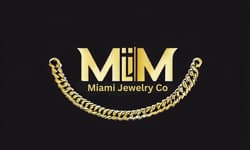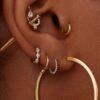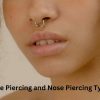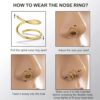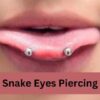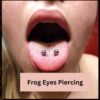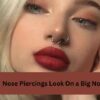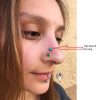Nose Piercing
Nose Piercing Placement: The Ultimate Guide for the Perfect Sweet Spot
Nose piercing is a popular way to express your style and personality. But how do you choose the best spot for your nose piercing? You need to consider your face shape, your health, and your preferences. You also need to know the different types of nose piercings and their pros and cons.
The ideal placement for a nose piercing hinges on an individual’s unique anatomy. For a traditional nostril piercing, the optimal spot is often where the nostril curves inward, commonly referred to as the “sweet spot.” This location offers a blend of aesthetics and comfort, ensuring the piercing complements the natural shape of the nose. Septum piercings, on the other hand, are best positioned in the thin skin separating the nostrils, avoiding cartilage and bone. It’s crucial to consult with a professional piercer who can assess your nose’s structure and recommend the best placement tailored to your anatomy.
In this comprehensive guide, we’ll explore:
- The intricate anatomy of the nose and its significance in piercing.
- Factors to weigh before committing to a piercing.
- The nuances of different piercing types, from nostril to bridge.
- The distinction between correct and incorrect placements.
- FAQs to clear any lingering doubts.
Are you ready to find out more?
Let’s dive in!
Contents
The Anatomy of the Nose
Before we jump into the nitty-gritty of nose piercings, it’s essential to understand the canvas we’re working with – the nose.
Different Nose Shapes and Types
Every nose is a masterpiece, unique in its own right. From the Roman nose with its pronounced bridge to the snub nose with its upward tip, each type has its own charm. But why is this important? Because the shape and type of your nose can influence the best piercing placement for you. It’s not just about what’s trendy; it’s about what complements your individual anatomy.
Key Landmarks of the Nose
Now, let’s talk about the structure. The nose isn’t just a lump of flesh; it’s a complex structure with several key landmarks:
- Cartilage: This flexible tissue gives shape to the nose. It’s tougher than the fleshy part but softer than bone, making it a popular piercing spot.
- Nostril: The soft, fleshy part at the bottom of your nose. It’s a common place for piercings, but its soft nature means it might take a bit longer to heal.
- Septum: The thin wall between your nostrils. It’s a trendy spot for piercings, but not everyone’s septum is suited for it. A professional can help determine if it’s right for you.
Factors to Consider Before Getting a Nose Piercing
Alright, now that we’ve covered the basics of nose anatomy, let’s discuss some critical considerations before you take the plunge.
Your Nose’s Shape and Size
Remember when we talked about different nose types? Here’s where it comes into play. Assessing your nose’s shape and size is crucial in determining the best placement. For instance, a high nostril piercing might look fantastic on a longer nose but could be overwhelming on a smaller one. It’s all about balance and harmony.
Desired Jewelry Type
The type of jewelry you have in mind can also dictate the best placement. For example:
- Studs: These are versatile and can be placed almost anywhere on the nose.
- Rings: Ideal for nostril or septum piercings. The curvature of the ring complements the natural curve of these areas.
- Screws: These have a unique design that requires a specific placement, usually on the nostril, to ensure they sit comfortably and securely.
Nostril Piercing
A nostril piercing is the most common type of nose piercing, and it involves piercing the cartilage that covers the nostril. You can choose to pierce either the left or the right nostril, depending on your personal preference and aesthetic. Some people believe that piercing a certain nostril has a symbolic meaning, such as femininity, masculinity, or spirituality, but there is no definitive evidence to support this. Ultimately, you should choose the nostril that you like best and that suits your face.
Nostril Piercing Placement Options
The placement of a nostril piercing can vary depending on your nose shape, your jewelry preference, and your personal style. You can pierce anywhere along the edge of the nostril, from the front to the back, and from the top to the bottom.
However, there are some general guidelines to follow when choosing the placement of your nostril piercing:
The Sweet Spot:
The most popular nose piercing placement is in the crease of the nostril, where the cartilage curves inward. This is also known as the “sweet spot”, as it is usually less painful and easier to heal than other placements.
Rings & Hoops Piercing Placement
If you want to wear a ring or a hoop in your nostril piercing, you may need to pierce lower or closer to the front of the nostril, as this will allow more room for the jewelry to fit comfortably. You may also need to wear a larger ring size than you would for a stud.
Studs Piercing Placement
If you prefer to wear a stud in your nostril piercing, you have more flexibility in choosing the placement of your piercing. You can pierce higher or further back on the nostril, depending on what looks best on your nose. However, keep in mind that the higher the placement, the harder it will be for you to change your jewelry on your own.
Planning for More Nose Piercings:
If you plan to get a second nostril piercing in the future, you may want to position your first one accordingly. You can either get a stacked or a double nostril piercing on the same side of your nose, or a symmetrical nostril piercing on both sides of your nose. Either way, you should leave enough space between the piercings to avoid irritation and infection.
Consultation is Key:
While it’s great to have a vision, consulting with a professional piercer can offer insights you might not have considered. They can assess your nose’s anatomy, provide recommendations based on your chosen jewelry, and even offer suggestions on angles that would best suit your facial features.


Nose Piercing Placement – Video Guide
Pros and Cons
A nostril piercing has many advantages and disadvantages that you should weigh before getting one. Here are some of them:
Pros:
- Versatility: Nostril piercings offer a broad spectrum of jewelry options. Whether you’re into minimalist studs or ornate rings, there’s something for every style.
- Quick Procedure: In the hands of a professional, the piercing process is swift, often completed within a minute.
- Universal Appeal: Suitable for a variety of nose shapes and sizes, a nostril piercing can enhance your natural features, adding a touch of uniqueness to your appearance.
Cons:
- Sensitivity: The nostril’s cartilage is rich in nerve endings and blood vessels. This can make the piercing and subsequent healing phases a bit uncomfortable for some.
- Extended Healing Time: On average, a nostril piercing takes 6 to 12 months to fully heal. This duration can vary based on individual care and healing capabilities.
- Risk of Complications: The nose’s exposure to environmental elements can increase the risk of infections. Additionally, the cartilage might sometimes resist foreign objects, potentially leading to jewelry rejection.
Bridge Piercing
A bridge piercing is a less common type of nose piercing, and it involves piercing the skin on the bridge of the nose, between the eyes. This is also known as an “earl” piercing, after Earl van Aken, who was one of the first people to have this piercing done. A bridge piercing can create a striking and unusual look, as it adds some contrast and dimension to your face.
Placement Options
The placement of a bridge piercing can vary depending on your facial structure and your jewelry choice. You can pierce anywhere along the bridge of your nose, from the top to the bottom, and from side to side. However, there are some general guidelines to follow when choosing the placement of your bridge piercing:
- The most common placement is in the center of the bridge of the nose, where it is flat and level. This is also the safest and most stable placement, as it reduces the risk of migration and rejection.
- If you want to wear a ring or a hoop in your bridge piercing, you may need to pierce lower or closer to the sides of the nose, as this will allow more room for the jewelry to fit comfortably. You may also need to wear a larger ring size than you would for a barbell.
- If you prefer to wear a barbell in your bridge piercing, you have more flexibility in choosing the placement of your piercing. You can pierce higher or further in on the bridge of the nose, depending on what looks best on your face. However, keep in mind that the higher or deeper the placement, the more likely it is for the jewelry to interfere with your vision or glasses.
Correct vs. Incorrect Nose Piercing Placement:
When considering a nose piercing, its placement stands out as a paramount factor. The position of the piercing influences its appearance, healing process, and overall comfort. Thus, it’s crucial to select a placement that complements your nose’s anatomy, aligns with your jewelry choice, and resonates with your personal style.
Correct Nose Piercing Placement:
- Nostril Piercing: The ideal spot is where the cartilage covering the nostril curves inward, often termed the “sweet spot.” This area typically offers a less painful experience and promotes quicker healing.
- Septum Piercing: The optimal location is the thin skin separating the nostrils, known as the columella or nasal septum. Absent of cartilage or bone, piercings here tend to be less painful and heal efficiently.
- Bridge Piercing: The best placement is on the nose’s bridge, between the eyes, ensuring the skin is flat and level. This position minimizes risks like migration and rejection.
Incorrect Nose Piercing Placement:
- Nostril Piercing: Piercing too high, too low, or too close to the nostril’s edge can lead to increased pain, potential infections, and an undesirable appearance.
- Septum Piercing: Piercing too high or low on the columella, or accidentally hitting the cartilage or bone, can result in pain, asymmetry, and other complications.
- Bridge Piercing: A placement that’s too high, too deep, or obstructs vision or eyewear can lead to pain, scarring, and misalignment.
FAQs
Where should your nose piercing be placed?
The best spot for a nose piercing depends on the type. For a standard nostril piercing, it’s often in the curve of the nostril. This spot is sometimes called the “sweet spot” because it’s thin and easier to pierce. For septum piercings, it’s the soft area below the hard cartilage in the middle of the nose. But everyone’s nose is different. It’s best to ask a professional piercer for advice on your nose.
What side do females get their nose pierced?
Historically, in places like India, many females chose the left side for cultural reasons. But today, the choice of side is more about personal preference. Some pick a side based on how it looks, while others might follow family or cultural traditions.
How painful is a nose piercing from 1-10?
Pain is different for everyone. But on a scale from 1-10, many people rate a nostril piercing between 3 and 5. The septum might be a bit less for some. The actual piercing is quick, but the pain can depend on your own comfort level and the skill of the piercer.
Should a girl get her nose pierced on the right or left side?
There’s no strict rule. Some girls choose based on cultural or family traditions. Others decide based on what they feel looks best on them. It’s all about personal choice.
How long does a nose piercing take to heal based on its placement?
The healing time for a nose piercing can vary depending on its placement. Typically, nostril piercings can take anywhere from 2 to 4 months to heal, while septum piercings might heal within 6 to 8 weeks. However, it’s essential to note that individual healing rates can differ, and following aftercare instructions is crucial for optimal healing.
Can I change the placement of my nose piercing after it’s done?
Once a nose piercing is done, its placement is permanent. If you’re unsatisfied with the placement, the best course of action is to let the piercing heal, retire it, and then get it re-pierced in the desired location. Always consult with a professional piercer before making such decisions.
What’s the most painless nose piercing placement?
Pain is subjective and can vary from person to person. However, many report that the septum, when pierced correctly through the “sweet spot” (a thin strip of soft skin), tends to be less painful than other areas. Nostril piercings, especially through the cartilage, might be slightly more uncomfortable for some.
How often should I consult with my piercer post-piercing?
It’s advisable to have a follow-up with your piercer 2-3 weeks after the initial piercing to ensure everything is healing correctly. Beyond that, if you notice any signs of complications or infections, or if you have concerns about the jewelry, it’s essential to consult with your piercer immediately.
Are there any nose shapes that can’t be pierced?
Almost all nose shapes can be pierced. However, the specific placement and type of jewelry might vary based on the anatomy. Some individuals might have a septum that’s too thick or deviated, making septum piercings challenging. It’s always best to consult with a professional piercer who can assess your anatomy and provide guidance.
Conclusion
In the realm of nose piercings, understanding one’s unique anatomy is paramount. It’s not merely about following trends or emulating what’s popular. Instead, it’s about recognizing the distinctiveness of your nose and choosing a placement that complements it. This ensures not only an aesthetically pleasing result but also a smoother healing process and long-term comfort. As you embark on this piercing journey, always prioritize your anatomy and seek professional guidance to achieve the best outcome.

Camila Luna is a passionate jewelry enthusiast and content creator at Miami Jewelry Co. With a focus on providing high-quality, Miami-style jewelry, Camila and her team specialize in a wide range of jewelry that includes bracelets, necklaces, earrings, and more
